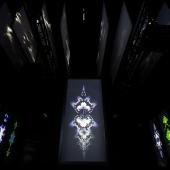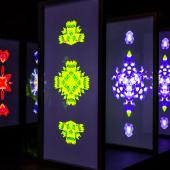All too often, technology distances us from the natural world. Distracted by digital screens and the pixelated pageantry flowing before our eyes, we grow increasingly oblivious to the IRL wonders blooming right outside our door.
Recently, Epson flipped that paradigm through Ecoterica, an immersive art installation, created by agency Second Story, that showcased the company's powerful projection systems while inviting visitors to reconnect with nature.
In June, some 2,000 attendees at the Infocomm 2019 audio/visual conference in Orlando explored a darkened, 400-square-foot, cocoon-like space where colorful, kaleidoscopic images of flora and fauna danced through the air, accompanied by sounds such as wind-song, crickets and bird cries.
Rendered in the abstract, once-familiar forms take on new dimension, prompting us to decode the shapes and, hopefully, ponder our place in Earth's complex, fragile ecology.
"We projected large-scale moving images constructed with elements of flowers and animals at eye-level," explains Second Story executive creative director Joel Krieger, who devised Ecoterica with the shop's executive technology chief Hunter Spence. "The experience feels intimate, personal and otherworldly. The emblems appear to be floating inside these rectangular frames or portals."
This next video, which strips out the explanatory titles, is perhaps more indicative of what Ecoterica guests encountered:
"In a way, this installation is making a statement about how these images of plants and animals should be very familiar to you, but of course they're not—they feel somewhat foreign, yet familiar at the same time," Krieger says. "Long ago, as indigenous oral cultures, we fluently spoke the language of the land. We could read the organic tapestry of life with the same ease we now read words on a page. As our society becomes further enveloped by technology, and we grow ever-distant from the earth, this once familiar language has become esoteric, understood only by a remaining few."
Check out the five ethereal images below. Can you identify the source material? (In each case, you're viewing a fairly common plant or animal.)
The first two are fish, followed by a mantis, jellyfish and blooming orchid.
If the forms seem elusive, even alien, that's the point. We've become strangers in our own world. And when that happens, we're little more than strangers to ourselves.
"We wanted people to lean in and say—what am I looking at? And have this revelation moment once they recognize the plant or animal that had been remixed to make the animated form," Krieger says.
He adds: "Deforestation, species extinction, using the ocean as a toxic dumping ground, even climate change—these are all just symptoms. The root of the problem is our profound and utter disconnection from nature. We are totally ignorant of the consequences of overpopulation and our hyper-consumptive lifestyles. We thought, what better place to make a provocation like this than at an event where visitors are likely to be hyper-connected to their tech, and totally detached from the natural world?"
Click on the first image and click/swipe through to see the gallery:
















Ecoterica, which will travel to additional venues in coming months, follows a growing trend of artful conceptual marketing. Droga5's biomorphic push for dietary supplements maker Thorne fits into this category, as does Lincoln's NYC waterfront pop-up that hummed with music and light. (Even Warner Bros.' more blatantly brand-centric Brooklyn basketball court takeover qualifies, as it transforms an existing environment in a bold, unexpected way.)
"We always enjoy getting to see how people interact with our work," Krieger says. "One visitor found a chair and placed it in front of the central panel and just sat there for 20 minutes. As this piece was meant to be viewed in the round, we hadn't considered calling out specific viewing points, but this was a great revelation that might make it into the next iteration of Ecoterica."
What's more, "during a lull, we decided to see if we could get more people to sit by just walking in and sitting or lying down on the floor ourselves," he recalls. "And it worked! Once people saw a cue that it was OK, they started to find spots to sit and just take it all in."











